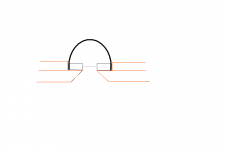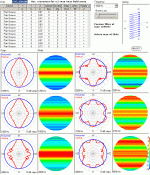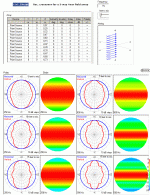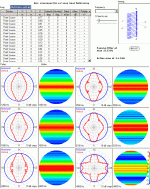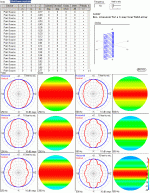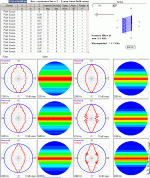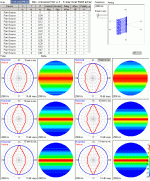line array
Well,
I have now made up my mind for a line array! (at least for now, or until someone gives me a better idea)
I will go for the RILA bass/mid drivers mentioned earlier, in sealed boxes, or perhaps aperiodic vented. I hope these with their rather low Fs (40Hz) will go deep enough to do without any subwoofer.
For tweeters, I'm determined to build a 1m long magnetostatic ribbon tweeter! (or perhaps take the easy way out and import "1m length" of the Dayton tweeters.)
with 130 mm C-C woofer distance, the crossover frequency should be kept below 2580 Hz, which shouldn't be any problem with the ribbon, might be a problem with the Dayton tweeters?
I'm going to give simple passive filters a try.
Any comments?
Well,
I have now made up my mind for a line array! (at least for now, or until someone gives me a better idea)
I will go for the RILA bass/mid drivers mentioned earlier, in sealed boxes, or perhaps aperiodic vented. I hope these with their rather low Fs (40Hz) will go deep enough to do without any subwoofer.
For tweeters, I'm determined to build a 1m long magnetostatic ribbon tweeter! (or perhaps take the easy way out and import "1m length" of the Dayton tweeters.)
with 130 mm C-C woofer distance, the crossover frequency should be kept below 2580 Hz, which shouldn't be any problem with the ribbon, might be a problem with the Dayton tweeters?
I'm going to give simple passive filters a try.
Any comments?
Regarding sealing the boxes, deep rather than shallow is the better deal. Deep means more insulation to absorb the back wave in the speaker.
Zarathu
Zarathu
dayton
Actually I was hinking about Dayton dome tweeters, either ND20 FA-6 or ND20 FB-4, stacked closely together into a 1m line. (just like in Zarathu's design)
However, building an own long ribbon tweeter seems very interesting!
Actually I was hinking about Dayton dome tweeters, either ND20 FA-6 or ND20 FB-4, stacked closely together into a 1m line. (just like in Zarathu's design)
However, building an own long ribbon tweeter seems very interesting!
Here is a comprehensive instruction in one way of doing a DIY ribbon - look under "lautsprecher"
Its in german but lots of pictures
http://www.michaelgaedtke.de/Home/index.html
My own project is a little different, but basically the same thing
One advantage is that with a 1meter slim ribbon, it will do 800hz easily
Disadvantage - often low sensitivity and impedance and it may rattle if you are not very carefull in designing, expencive neo magnets
And be carefull ... once you have started this thing, you may never look back
Its in german but lots of pictures
http://www.michaelgaedtke.de/Home/index.html
My own project is a little different, but basically the same thing
One advantage is that with a 1meter slim ribbon, it will do 800hz easily
Disadvantage - often low sensitivity and impedance and it may rattle if you are not very carefull in designing, expencive neo magnets
And be carefull ... once you have started this thing, you may never look back
Attachments
Problem with making your own drivers....
The problem with designing your own ribbons and building them yourself is that most manufacturers don't get them right. If you go to Zaph Audio and look at his comparison to a simple quality $35 dome tweeter, only one of them exceeds the dome in distortion and FR quality.
That's the B&G Neo 3. All the rest are inferior to a simple medium expensive dome tweeter.
So if most manufacturers can't do a decent job with lots of resources, what makes any of us think we can suddenly beat them out, in our first try?
Have you then tested your finished version for flatness of FR and low distortion?
Zarathu
The problem with designing your own ribbons and building them yourself is that most manufacturers don't get them right. If you go to Zaph Audio and look at his comparison to a simple quality $35 dome tweeter, only one of them exceeds the dome in distortion and FR quality.
That's the B&G Neo 3. All the rest are inferior to a simple medium expensive dome tweeter.
So if most manufacturers can't do a decent job with lots of resources, what makes any of us think we can suddenly beat them out, in our first try?
Have you then tested your finished version for flatness of FR and low distortion?
Zarathu
diy ribbon
I agree that the chance of getting it right the first try is small. I wouldn't have considered building unless I had stumbeled upon a detailed concept developed through several years. I will more or less copy a well proven concept.
I agree that the chance of getting it right the first try is small. I wouldn't have considered building unless I had stumbeled upon a detailed concept developed through several years. I will more or less copy a well proven concept.
Re: diy ribbon
Where? What kind of equipment is needed? Where is the research on completed ribbons by amateurs? Just interested? I'm not above doing it too if I could figure it wasn't some piece of C**P when I was done. And cost? Would it be better than a line of Dayton Neo 20FA's at $3.50 each?
maghen said:I agree that the chance of getting it right the first try is small. I wouldn't have considered building unless I had stumbeled upon a detailed concept developed through several years. I will more or less copy a well proven concept.
Where? What kind of equipment is needed? Where is the research on completed ribbons by amateurs? Just interested? I'm not above doing it too if I could figure it wasn't some piece of C**P when I was done. And cost? Would it be better than a line of Dayton Neo 20FA's at $3.50 each?
This is the one:
http://www.dahlbergaudiodesign.se/engelska/del1.htm
According to the builder himself, the sound is extremely good (whatever that is worth), I believe he has also done a lot of frequency measurements.
http://www.dahlbergaudiodesign.se/engelska/del1.htm
According to the builder himself, the sound is extremely good (whatever that is worth), I believe he has also done a lot of frequency measurements.
Not me, babes! I looked at the pictures and instructions. There is no chance that I could make a ribbon using those instructions that will beat out my line of neo tweeters.
"Even a speck of dust will cause a problem". Yeah where would I find a clean room without a speck of dust. Surely not my workshop.
More power to you, you're a better builder than I, Gunga Din!
Zarathu
"Even a speck of dust will cause a problem". Yeah where would I find a clean room without a speck of dust. Surely not my workshop.
More power to you, you're a better builder than I, Gunga Din!
Zarathu
Hey, I haven't built it yet... and I still haven't made up my mind. 60 Dayton ND20FA will cost me $419, it might be a good deal...
maghen said:Hey, I haven't built it yet... and I still haven't made up my mind. 60 Dayton ND20FA will cost me $419, it might be a good deal...
Do you live in Sweden?
line array Post #41 Well,I have now made up my mind for a line array! (at least for now, or until someone gives me a better idea) I will go for the RILA bass/mid drivers mentioned earlier, in sealed boxes, or perhaps aperiodic vented. I hope these with their rather low Fs (40Hz) will go deep enough to do without any subwoofer……
Magnus,
The first two drivers you brought up in your post #15 are members of the lowest quality scale of drivers you can find in Sweden.
The data given for those drivers are sold with the sole purpose to be incomplete (advertised year after year) and with non-consistent data when compared to the other sales information given, thus very misleading and in my opinion should be avoided.
You should be very suspicious when reading the catalogue specification for the Rila speakers as all the different types are advertised exactly 40,50,60 W, but one have a sensitivity of 89 dB/1m and the fs are exactly 40, 50, 60, 70, 80, or 90 Hz. and no other T/S data.
The only conclusion you should make is that all the specifications are faked.
My proof for this statement is by an example. Take Rila RW 4005 with the following catalogue minimized specification: 4” 40 W 6-Ohm paper cone bass driver with sensitivity of 89 dB/SPL and fs= 80 Hz. and compare with picture at:
http://www.diyaudio.com/forums/attachment.php?postid=1102554&stamp=1168387560
I found no numbers to be correct besides the 6-Ohm nominal impedance value!
The Rila 5048’s could work as W-drivers in an OB array but I suspect a closed box about >= 10 L/driver is needed even for an aperiodic type with a LF cut-off near 100 Hz.
You wrote in post # 29:
I have never listened to any near field line array, but from what I read and see, people seem to be very satisfied with arrays, even with "cheap" drivers.
Since I would like to (at least at first) get away with a 2-way array without subwoofer, I am looking at 5,25" drivers. The problem gets quite clear when reading James R. Griffin's excellent paper; With a woofer spacing of 130 mm, maximum crossover frequency should be 2580 Hz to avoid cancellations. To get up to 3000 Hz my calculations say max. 112 mm woofer spacing... (hard to obtain with 5,25" drivers)
So, what do you think. What would be worse? Using a crossover frequency well below 3000, or using a 130 mm woofer distance with 3000 Hz crossover frequency? I am aware that neither would be optimal, but perhaps acceptable?
The size of this driver is 13.5 cm# and you mentioned to use it up to 2580 Hz.
Using Jim Griffins paper and the rec. c-c= lambda/2 criteria for this driver you get: 344/(2x0.135) =1274 Hz to crossover to a tweeter line with ordinary 12 dB filters.
Look the first submitted picture1(8), no filter can suppress the severe loobing at twice the frequency, about 2548 Hz.
But if you can live with severe off axis loobing/bad integration, huge crossover dips (even peaks) by using T drivers cutting off higher than 3 kHz you could of course try the same crossover at 2x 1274 = 2548 Hz with or just ignore any W crossover and superimpose the T dispersion on the W driver as it would be of a flat performing FR of WR type without any filter and hope for the best, even if the main lobe now are loobing at random and pointing at an angle not perpendicular to the baffle.
If this Nearfield line array consists of 2.4 m x 70% / 0.135=12.44 = 12 W-drivers, the possible in room low cut-off frequency will be at about f = 1 / (9 x 2.4x70%) = 66 Hz but only if the array is equipped with mid bass drivers that in the reality can exceed this frequency in an enclosure, not an upper bass driver like the Rila 5048 driver resembles at most.
Again, if you still hope for the best and ignore the side effects like the deep lower-mid-bass LF dip that comes with placing the arrays close to the room corners, now a necessity if you still believe the Rila 5048 could somewhat extend to the low bass octave beginning at 40 Hz but this wont happen as the line array guaranteed cut-off frequency is at 3x66 Hz = 198 Hz and 66 Hz with help from the mirrored room effect.
What you will gain with this set-up is some lower upper bass (160 down to 80 Hz), maybe some weak mid bass (40-80 Hz) but never the room filling low bass (20-40Hz) replacing the impression of a sub.
….For tweeters, I'm determined to build a 1m long magnetostatic ribbon tweeter! (or perhaps take the easy way out and import "1m length" of the Dayton tweeters.)
with 130 mm C-C woofer distance, the crossover frequency should be kept below 2580 Hz, which shouldn't be any problem with the ribbon, might be a problem with the Dayton tweeters? I'm going to give simple passive filters a try. Any comments?
A Dayton ND20FB with a simple 90-degree wave-guide that will work fine down and even below 2000 Hz.
See picture 8(8) or:
http://www.diyaudio.com/forums/attachment.php?postid=1194160&stamp=1177617133
No simple passive filter at 2548 Hz will suffice if using the Rila 5.25” driver as W+ M driver in a Near field line array, only a 3”driver would integrate easily with a horizontally wave guided Dayton ND20FB driver.
Another treads with similar questions:
http://www.diyaudio.com/forums/showthread.php?threadid=102084&pagenumber=1
http://www.diyaudio.com/forums/showthread.php?threadid=99960&perpage=10&pagenumber=2
Here is a inexpensive driver, the 3” Aura NS3 194 8E that work very well in a Nearfield line array together with the Dayton ND20:
http://www.madisound.com/catalog/product_info.php?products_id=729
b
1(8)
Attachments
- Status
- Not open for further replies.
- Home
- Loudspeakers
- Multi-Way
- which loudspeaker design?
